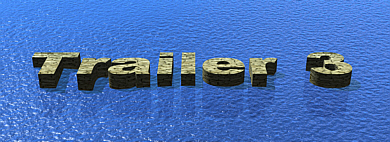|
Hier sind wir nun bei der Königs-Disziplin in der Filmbearbeitung. Wo früher noch Künstler mit Farbpinsel auf Glasscheiben gemalt haben (daher der Begriff "Matte-Painting"), werden die heutigen Effekte überwiegend mit 3D-Programmen erstellt. Es gibt heutzutage kaum einen Blockbuster, der nicht ein 3D-Programm benutzt hat und die Qualität ist mittlerweile so gut, daß man den Unterschied kaum noch merkt, bzw. oftmals nicht mehr unterscheiden kann, ist das jetzt wirklich echt oder virtuell in einem Computer-Programm entstanden.
Oder anders gefragt: Wer hat die vom Lastwagen herunterfallenden Bäume in "Final Destination 2" für echt gehalten? Ich war Anfangs davon überzeugt, die sind echt. Bis ich im Internet das MakingOf dazu gesehen habe und feststellen mußte, die sind aus dem Computer...
Seit ich mich selbst mit 3D-Programmen beschäftige, weiß ich, warum die Liste der Leute bei Filmen wie "Shrek" oder "Findet Nemo" so unglaublich lang ist. Es gibt bei 3D-Programmen mehrere Bereiche und würde jemand alle Bereiche perfekt beherrschen, wäre er in meinen Augen ein Genie. Bei solchen Animations-Filmen gibt es Leute die nichts anderes machen als das Modelling, also das Erstellen der virtuellen Charactere. Wieder andere sind nur für den Hintergrund zuständig. Wieder andere machen nur die Beleuchtung, also das setzen von Objekten die Lichtquellen simulieren. Andere machen nur die Oberflächen und wieder Andere nur die Bewegungen der Charaktere. Und wie gesagt, seit ich mich selbst damit beschäftige, weiß ich, wie kompliziert es ist. Daher meine Bezeichnung "Königs-Disziplin". Stellt euch vor ihr habt einen leeren Raum vor euch und müßt ihn erst einmal füllen. So frei nach dem Prinzip "es werde Licht" setzt ihr in einem virtuellen, dreidimensionalen Raum ein Objekt das Licht erzeugt. So, jetzt seht ihr erstmal was. Nein? Ihr seht nichts? Ist ja auch klar, in eurem virtuellem Universum ist ja noch gar nichts vorhanden. Also erzeugen wir eine Fläche, der wir die Farbe eines dunklen Blau´s geben. Damit der Hintergrund nicht schwarz aussieht, geben wir ihm eine hellblaue Farbe. Erinnert jetzt schon mal entfernt an einem blauen Himmel mit einem Meer. Die Grundobjekte sind gesetzt. Damit das ganze aber noch ein wenig echter und natürlicher Aussieht müssen wir uns jetzt überlegen: Wie sieht eigentlich Wasser aus? Wie wird Licht von ihm refklektiert? Welche Bewegungen macht es? Und dann wird es mächtig kompliziert. Man muß die Größe der Glanzpunkte definieren, die eine Lichtquelle von der Wasseroberfläche zurück wirft. Muß ein Oberflächenmuster erzeugen, in der Fachsprache als "Shader" bezeichnet. Wellenbewegungen, Transparenz, Veränderung des Aussehens bei anderem Blickwinkel definieren, usw.
Anders ausgedrückt: je mehr Dinge man definiert und je genauer diese Dinge am Original (den Eigenschaften des Meeres in der Natur) sind, desto realer wirkt unser Wasser später. Das kann so real werden, daß auf einem Standbild der Unterschied nicht mehr zu erkennen ist (siehe Pic oben - zur Vergrößerung draufklicken). Aber wie gesagt, alles sehr, sehr kompliziert und wofür Gott anscheinend sechs Tage gebraucht hat, habe ich mehrere Monate dran gerarbeitet und mein Compi circa 36 Stunden dran gerechnet. Wohl gemerkt: 36 Stunden an 29 Sekunden Film, denn jedes einzelne Bild muß im virtuellen, dreidimensionalen Raum mit den ganzen Eigenschaften wie Licht, Schatten, Oberfläche, usw. berechnet werden. |




